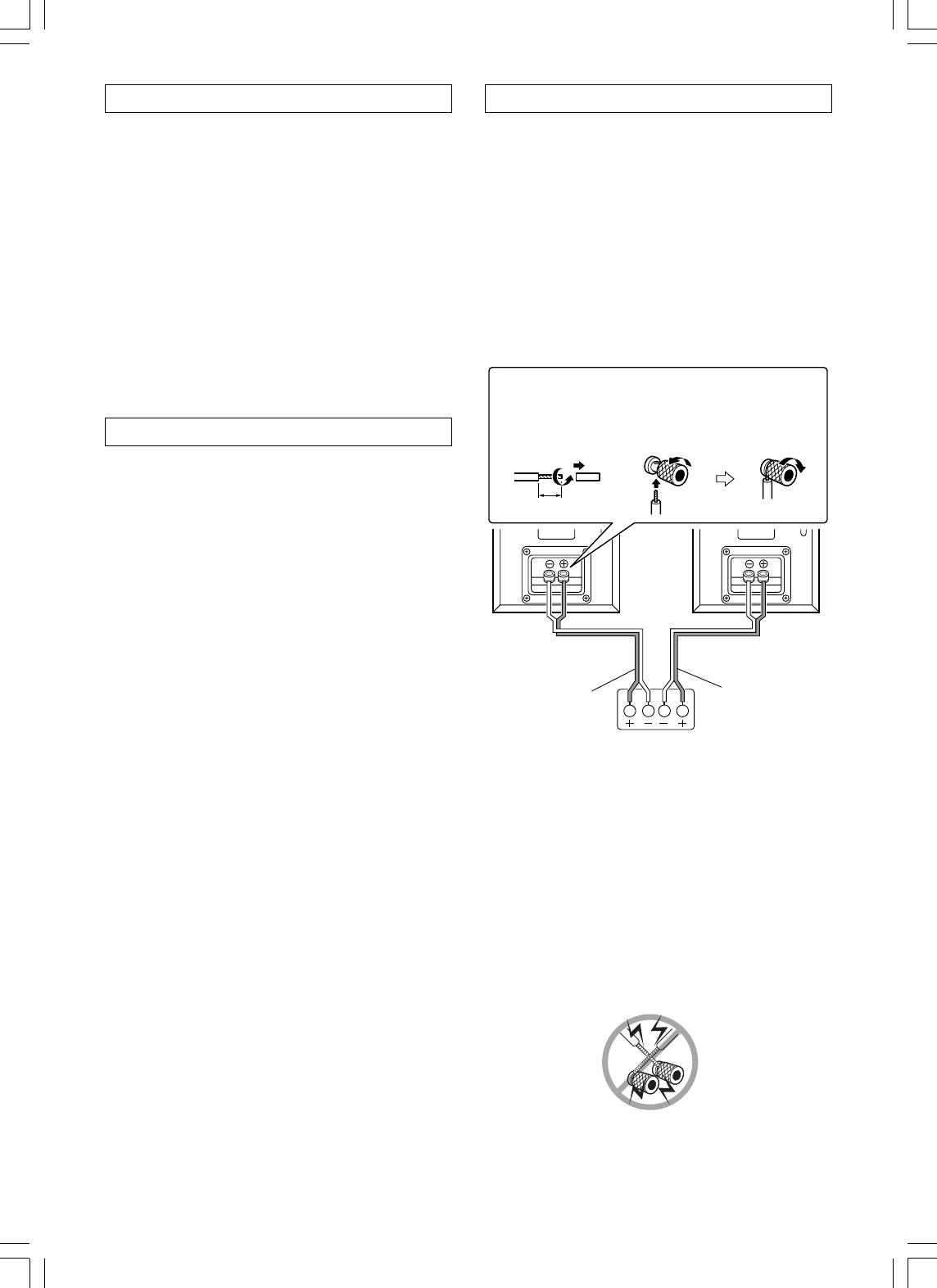
En-2
Connection
• Turn the sound volume to the minimum and disconnect the
power cord from the amplifier before connecting the
speaker cables.
• The nominal impedance of this speaker system is 6 Ω. Use
only amplifiers capable of handling this impedance.
• Use the supplied speaker cables to connect between
speaker’s input terminals and the amplifier’s speaker
terminals as illustrated below.
• Connect the speaker cables securely to the terminals, with
the core wires twisted properly. In this case, make sure that
the core wires do not touch each other. Note that a short
circuit in core wires may result in damage to the amplifier.
Before using this unit
• The speaker cabinet is made of wood and is therefore
sensitive to extreme temperatures and humidity. Avoid
placing the speaker systems in locations subjected to
direct sunlight, or in smoky or in humid places, such as
near an air conditioner, humidifier, bathroom, or kitchen.
Doing so may result in damage to the speaker.
• Place the unit on a rigid, level surface. Placing it on a
slanted surface or weak base not only may cause the unit
to fall, but also results in decreased sound quality.
• Be sure to turn off your amplifier before connecting the
speaker system. Connecting them with the amplifier’s
power on may result in damage to the amplifier or the
speaker system.
• Keep water or other liquids away from the unit. If water is
spilled into the unit, not only the unit but also the speakers
themselves may be damaged.
Precaution on use
• This speaker system can handle the specified input power
when it is used for ordinary music reproduction. If the
following abnormal signals are fed to the speaker,
however, an overcurrent may flow in the internal circuits,
causing burning or breakage of the wires even if the input
power is below the specified rating.
1. Noise produced when FM station is not tuned in
2. Sound produced when fast-forwarding cassette tape
deck
3. High-frequency sound generated by an oscillator, an
electronic musical instruments, etc.
4. Oscillating amplifier signals
5. Special test signals produced by audio checking CD,
etc.
6. Sound produced when connecting or disconnecting
audio connection cables (Always turn off the amplifier’s
power before connecting or disconnecting cables.)
7. Howling when a microphone is used
• Do not place magnetic objects such as screwdrivers and
iron parts near the tweeter since they use speakers with
strong magnets. Otherwise, the objects may be attracted,
causing injury or damaging the diaphragm.
Before turning on the amplifier’s power switch:
• Make sure that the positive (+) and negative (–) speaker
cables do not contact each other. Otherwise, a short-circuit
may occur, causing damage to the amplifier.
• Be sure to connect the speaker cables with correct polarity
(connect the speaker’s positive (+) and negative (–)
binding posts with the amplifier’s corresponding speaker
terminals). Reversed polarity results in impaired bass-
range reproduction, causing mislocalization of the sound
image. Also, be sure to connect the Right and Left
speakers with the amplifier’s corresponding speaker
terminals.
• Pull lightly on the speaker cables to ensure that they are
connected firmly.
Connecting to AV amplifier
RL
15mm
1. Strip off the end
of plastic skin,
and give a twist
to the core wire.
2. Slacken the
screw and thread
the core wire
deep enough into
the hole.
3. Hold the core wire
tight by fastening
the screw in the
direction of an
arrow.
Right hand side
speaker (R Channel)
Left hand side speaker
(L Channel)
Red cord side
Red cord side
Speaker terminals of the amplifier










